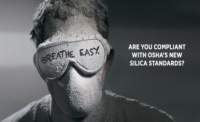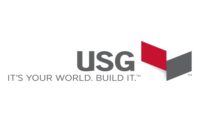Revised OSHA Silica Standards Overview
Saddle up with OSHA Silica Standards






OSHA has reduced the permissible exposure limit for crystalline silica. The new standards were to take effect June 23, but OSHA delayed implementation until recently. These new standards are now implemented.
Key provisions of the revised silica standard include:
- Reduction of the permissible exposure limit for dust from 100 μg/m3 to 50 μg/m3 over an eight-hour time weighted average and respirable silica below 25 μg/m3 as an eight-hour time-weighted average.
- Requiring engineering controls to limit worker exposure to the permissible exposure limit.
- Designate a competent person to develop and implement a written exposure control plan.
- Restrict housekeeping activities that may expose workers to respirable silica.
- Provide respirators to workers when engineering controls do not limit respirable silica below the required levels.
- Offering medical exams to highly exposed workers and training workers on silica risks and how to limit exposures.
- Provide medical examinations, including x-ray imaging, every 3 years.
- Maintain records of workers silica exposure and medical exams for 30 years.
What is Crystalline Silica?
Crystalline silica is a basic component of soil, sand, granite, and many other minerals. Quartz is the most common form of crystalline silica. Cristobalite and tridymite are two other forms of crystalline silica. All three forms may become respirable size particles when workers chip, cut, drill or grind objects that contain crystalline silica.
Exposure to silica occurs during many different construction activities, but a few of the most common are concrete drilling, concrete grinding and concrete block cutting and sawing. For many activities that commonly produce high levels of dust or respirable silica, OSHA has provided exactly what type of engineering controls and, if applicable, assigned protection factors respirators that are necessary to protect the worker.
These engineering controls can be found in OSHA’s Table 1 (visit osha.com to view this Table).
For example, when workers are using a walk-behind-saw to cut concrete, the saw must be equipped with an integrated water-delivery system that continuously feeds water to the blade. If the worker is performing this work outdoors, no respirator or assigned protection factor is required. However, if the worker is saw-cutting indoors, the worker must also use a respirator that will provide an assigned protection factor rating of 10. Air-purifying respirators range from a half mask/dust mask or the half mask/cartridge filter-type respirator to a hood powered air-purifying respirator. For an assigned protection factor of 10, a dust mask or half mask/cartridge filter respirator must be used.
Another common activity, addressed in Table 1, is the use of a handheld grinder for uses other than mortar removal. One of the ways to comply with Table 1 is to equip the grinder with a commercially available shroud- and dust-collection system. The dust-collection system must provide 25 cubic feet per minute or greater of airflow per inch of wheel diameter, a filter with 99 percent or greater efficiency, and a cyclonic pre-separator or filter-cleaning mechanism. If the grinding is performed outdoors, no respirator is required, but if the work is performed indoors or in an enclosed area, an assigned protection factor of 10 is required when the activity exceeds four hours. If the activity will last less than four hours, no respirator or assigned protection factor is required.
Table 1 provides the engineering controls to manage dust and respirable silica and, if necessary, the type of respirator to be used for a number of activities. Most of these activities are related to cutting, grinding, drilling crushing, jackhammering concrete or asphalt surfaces. When it comes to installing gypsum board, sanding joint compounds, mixing plaster materials or applying fireproofing, etc., OSHA and Table 1 do not address what engineering controls or respirator requirements must be employed.
OSHA Section 1926.1153(a) states:
… applies to all occupational exposures to respirable crystalline silica in construction work, except where employee exposure will remain below 25 micrograms per cubic meters of air (25 μg/m3) as an eight-hour time-weighted average under any foreseeable conditions.
When the permissible exposure limit for dust is less than 50 μg/m3 and the respirable silica levels are less than 25 μg/m3, no engineering controls or respirator program are required. However, how do we know what the permissible exposure limit is from our activities, or how much respirable silica, referred to as the action level, is generated from our activities? It is the employers’ responsibility to determine if the permissible exposure limit is less than 50 μg/m3 and/or the action level or respirable crystalline silica, is less than 25 μg/m3 for the type of work their employees perform.
OSHA Section 1926.1153(d) (1),
Permissible exposure limit. The employer shall ensure that no employee is exposed to an airborne concentration of respirable crystalline silica in excess of 50 μg/m3, calculated as an eight hour workday.
The employer is responsible, but how does the employer determine whether our activities will exceed the permissible exposure limit or not? Rather than implementing a respirator program for the entire workforce, there are two methods approved by OSHA to ensure that the permissible exposure limit and action level are below the established OSHA standards.
Section 1926.1153(d)(2)(ii):
Performance option. The employer shall assess the eight-hour time-weighted average of exposure for each employee based on any combination of air monitoring data or objective data sufficient to accurately characterize employee exposures to respirable crystalline silica.
Or, Section 1926.1153(d)(2)(iii)(A):
The employer shall perform initial monitoring to assess the eight-hour time-weighted average of exposure for each employee based on one or more personal breathing zone air samples that reflect the exposures of employees on each shift, for each job classification, in each work area. Where several employees perform the same tasks on the same shift and in the same work area, the employer may sample a representative fraction of these employees in order to meet this requirement. In representative sampling, the employer shall sample the employee(s) who are expected to have the highest exposure to respirable crystalline silica.
Section 1926.1153(d)(2)(iii)(B)
If initial monitoring indicates that employee exposures are below the action level, the employer may discontinue monitoring for those employees whose exposures are represented by such monitoring.
In wall and ceiling construction, there are a number of activities that could be expected to result in dust levels that could exceed the permissible exposure limit of 50 μg/m3. There also could be products that contain silica that may result in employee exposure greater than the action level of 25 μg/m3. Those activities are: drywall installation, with or without the use of routers; sanding taping compounds; either by hand, pole or vacuum; floor sweeping with a compound; mixing fire-proofing; Portland cement or gypsum plaster mixing; roto hammering into concrete; cutting of certain drywall products that require the use of a power saw; and chop saw activities.
Of these activities, only taping compounds list silica as an ingredient and the level of respirable silica is generally less than .7 percent, but other products, such as fireproofing materials and plaster, may contain quartz or may result in dust levels that exceed the permissible exposure limit. Accordingly, all of these activities would require air monitoring, per OSHA guidelines, to determine that their individual permissible exposure limit or action level was below OSHA standards.
Recently, several wall and ceiling contractors have undertaken or are undertaking air monitoring of these activities. Initial results thus far have been promising. The installation of drywall, sanding of joint compounds, chop saw activities, roto hammering with vacuum collection, sweeping of floors with a sweeping compound, have all been reported to be below 50 μg/m3 permissible exposure limit and below the action level of 25 μg/m3. Additional testing is being conducted on dry mix activities, but preliminary results indicate that for mixing these products, engineered controls and/or a respirator program may be necessary.
Although the majority of current air-monitoring testing has been performed in Northern California by the Wall and Ceiling Alliance contractors, such data and future data derived from air monitoring by others in the wall and ceiling industry may be used as shared evidence also known as objective data. Shared evidence shows that specific activities in the wall and ceiling industry do not exceed the established permissible exposure limit and action levels; therefore, those activities require no engineering controls or respirator program. The Northwest Wall and Ceiling Bureau, in association with members of the Northwest Wall and Ceiling Contractors Association, participated in air monitoring during the month of July, performed by the Washington State Department of Labor and Industries.
In its simplest form, the protocol for testing involves the worker wearing a dust/respirable silica collection device at the collar level for an eight-hour day. The collection device is then taken to an approved testing facility where the level and type of particles are determined. The results are then provided for respirable particulates, less than 50 μg/m3, and for respirable crystalline silica quartz, respirable crystalline silica cristobalite and respirable crystalline silica tridymite, less than 25 μg/m3 permissible exposure limit and less than action level.
The respirator program outlined by OSHA is complicated and the implementation, maintaining records and training of the workforce is the responsibility of the employer. In very brief form: A respirator program shall be provided to the employee, at no cost, and it will include a medical examination and X-ray for each employee that is required to use a respirator for thirty or more days per year (one hour per day equals one day). The employee participating in the respirator program shall undergo a complete exam by a physician or other licensed health care professional every three years.
The employer is responsible to ensure that all medical examinations and procedures are performed by a physician or licensed healthcare professional. The employer is also responsible to ensure that the physician or licensed healthcare professional explains the results of the medical exam to the employee. The employer is not permitted to receive the results of the examination other than to be provided with a statement from the physician or licensed healthcare professional of any recommended limitations to the employee’s exposure to respirable crystalline silica or limitations to the use of respirators.
The employer must provide a written description of the exposure-control plan and the procedures used to restrict access to work areas, when necessary, to minimize the number of employees exposed to respirable silica and their level of exposure, including exposures generated by other employers or sole proprietors. The employer shall designate a “competent person,” who will make frequent and regular inspection of job sites, materials and equipment to implement the written exposure-control plan.
The employer shall include respirable silica in the program, comply with the hazard communication standard, and ensure that each employee has access to labels on containers of crystalline silica and safety data sheets. The employer also make sure that the employee is trained in accordance with the provisions of the hazard communication standard, which includes information on the potential of cancer and how it effects the workers lungs, kidneys and immune system.
The employer shall ensure that each employee can demonstrate knowledge and understanding of at least the following:
- The health hazards associated with exposure to respirable silica.
- Specific tasks in the workplace that could result in exposure to respirable silica.
- Specific measures the employer has implemented to protect employees from exposure to respirable silica, including engineering controls, work practices and the use of respirators.
- The identity of the “competent person” designated by the employer.
- The purpose and a description of the medical surveillance program.
Record keeping will also be very involved and includes the following:
- The employer shall make and maintain an accurate record of all exposure measurements taken to assess employee exposure to respirable silica.
- The employer shall make and maintain an accurate record of all objective data relied upon to comply with the requirements.
- The employer shall make and maintain accurate records for each employee covered by the medical surveillance. The records shall be maintained for thirty years.
Air monitoring that is currently being performed will determine which of activities will or will not require the use of respirators and/or engineering controls to meet the OSHA silica standards. We can expect that once the results of these tests are provided to OSHA for review, OSHA will add these activities to Table 1. Based upon preliminary results, I anticipate that drywall installations, mixing of wet joint compounds, application of joint compounds, sanding joint compounds, chop-saw activities, and scrapping and floor sweeping with a compound will not require engineering controls or respirators. I believe the use of roto-hammers will be restricted to a vacuum-attachment type and no respirator requirement will be needed, but that mixing of dry ingredients, such as Portland cement and gypsum plaster mixes may require the use of respirators and compliance to the respirator program or designed engineering controls that reduce dust or respirable silica to levels below those recently established
by OSHA.
Looking for a reprint of this article?
From high-res PDFs to custom plaques, order your copy today!








